iBUYPOWER Erebus GT Review: Ivy Bridge and NVIDIA's GeForce GTX 680 in SLI
by Dustin Sklavos on April 27, 2012 2:00 AM ESTGaming Performance
Given what we've seen on the last page of the pair of GeForce GTX 680's in the iBUYPOWER Erebus GT, it's reasonable to assume we'll see them pretty much at the top of every chart. Thankfully we're starting to accumulate a decent amount of data to draw comparisons from with our new gaming suite.

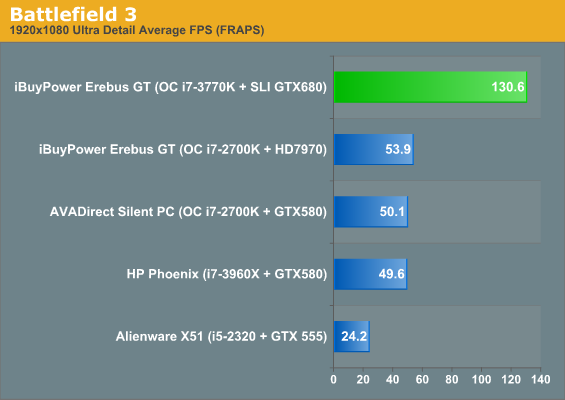
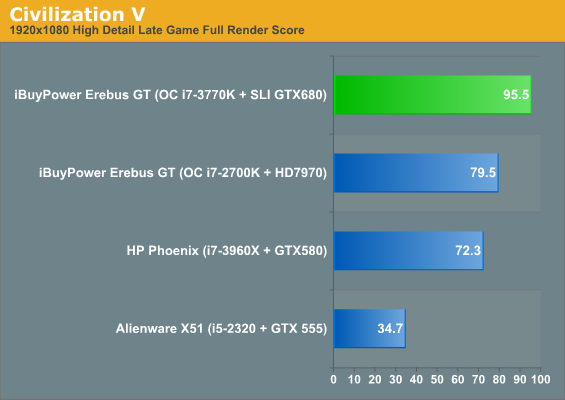
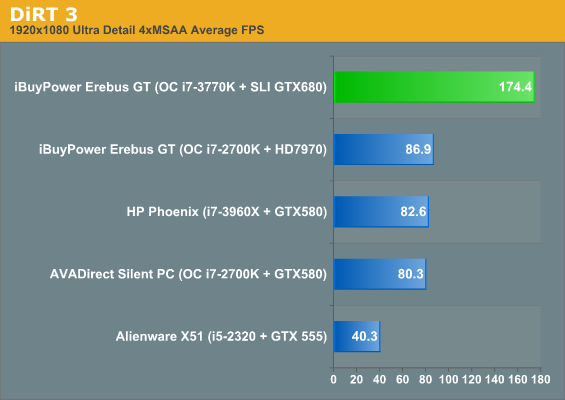

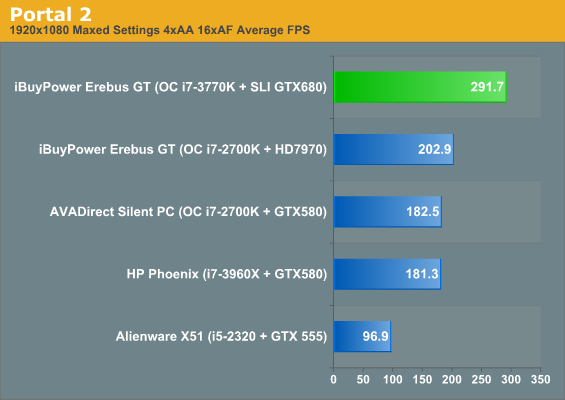
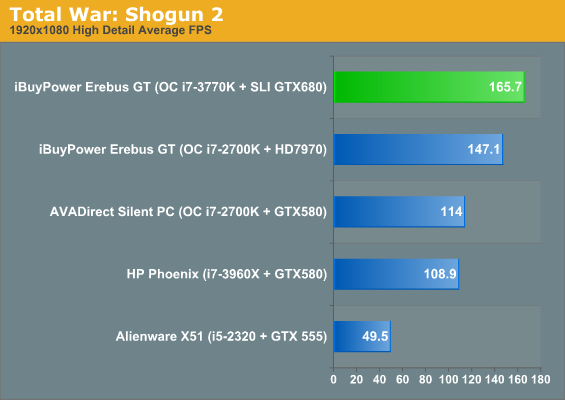
Bottom line, two GTX 680s is essentially excessive for 1080p. That's to be expected, but I was so stunned by the performance in Battlefield 3 that I actually had to double-check my results. Battlefield 3 has been fairly punishing on most of the systems I've tested, but the GTX 680s just brush it off. In other titles, we clearly hit CPU limits before the GPUs can reach their stride—Civilization V, Elder Scrolls: Skyrim, and Total War: Shogun 2 are clearly CPU limited at this point, and Portal 2 is only somewhat less so.
At the same time, everything isn't quite sunny for SLI right now. Since the GTX 680 is fairly new, each driver release from NVIDIA is going to become that much more important. The 301.10 drivers, for example, weren't entirely stable compared to the 301.24 betas, which could run DiRT 3 in surround without issue. I also had trouble actually configuring surround in the first place on the 301.10s, problems that didn't resurface in the 301.24s. The 301.10s also produced substantially lower SLI performance in Portal 2 (still 130+ fps) than the 301.24s.
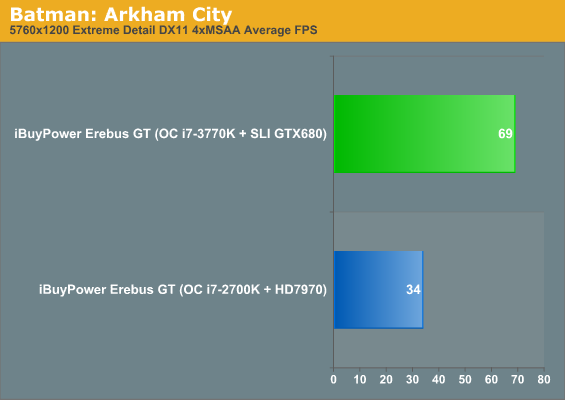
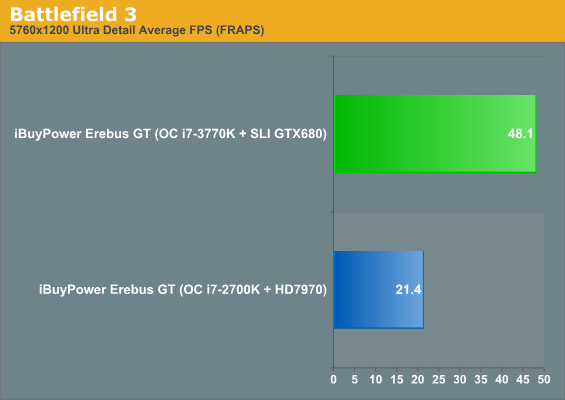
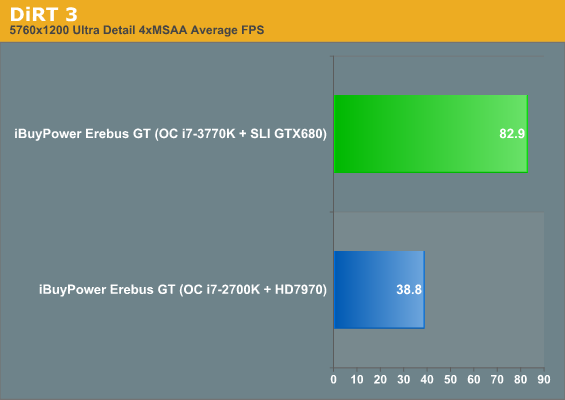
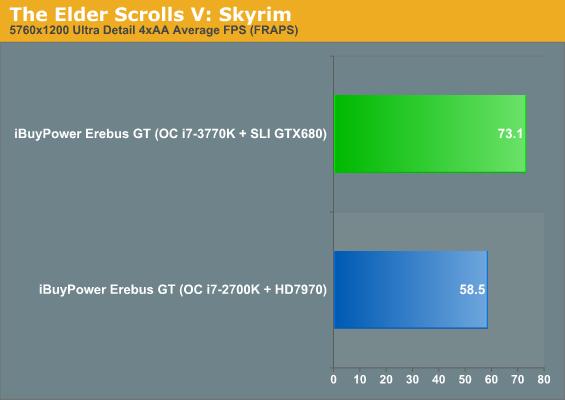

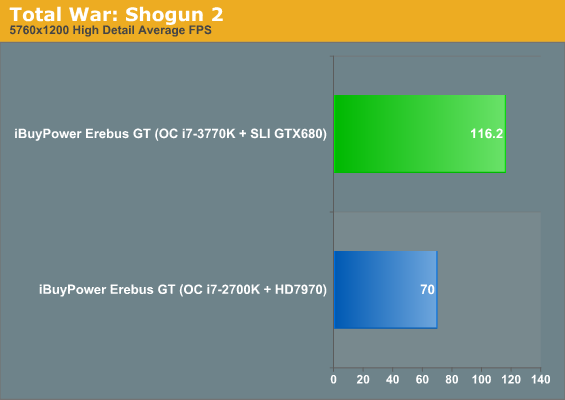
I'm sure it surprises no one that the pair of GTX 680s is able to provide playable experiences across every game at our highest resolution and settings. Battlefield 3 does bring the hammer down, though; triple the resolution and the performance is sliced pretty linearly down to about a third of what it was. If you want to run at surround resolutions with anti-aliasing enabled, though, the GTX 680s can do it. Interestingly, Skyrim is still apparently hitting CPU bottlenecks even at 5760x1200.










64 Comments
View All Comments
Money Loo - Friday, April 27, 2012 - link
Chalk up another two for avoiding iBuypower. As stated before both my brother and I had absolutely horrendous experiences with both build quality and customer support. I would personally avoid them like the plague.Maybe company computers or reviewers they take care of, but as far as the general public is concerned they are horrible.
Epinions - 2 and a half stars, many negative 1 star reviews
http://www.epinions.com/webs-Web_Services-All-Merc...
Resellerrating is the first google search and it lists them fairly highly, though.
So really I can only speak for my own personal experience with them, and it was not good twice in a row. To call someone a troll just because they stated their own personal opinion as well seems a bit much.
shin0bi272 - Friday, April 27, 2012 - link
Ive never done water cooling so forgive me if this sounds stupid but what is going on with that vga cooling? They have one cards cooling coming directly off the cpu and the other directly off the reservoir? Wont that lead to one card being much hotter than the other?JarredWalton - Friday, April 27, 2012 - link
Liquid-cooling allows the cooling medium (water) to store a LOT more energy than air-cooling, with the net result being that as long as your pump has a decent flow rate, it's not a huge concern. By the time the water passes through the CPU and on to the GPU, it might be a few tenths of a degree warmer is all. If you were doing tri-SLI, perhaps parallel would help the third card more, but for 2-way it's not enough to really matter. Here's a lengthy posts someone with more experience put together on the subject:http://www.overclock.net/t/519131/series-versus-pa...
Nickel020 - Friday, April 27, 2012 - link
It doesn't make much of a (noticeable) difference, but it does show that whoever set up that loop doesn't know all that much about watercooling unfortuantely. So maybe this isn't the only detail they missed - add up a couple of those smaller details in the setup and even if they only are around 0.5C each, together they do make a noticeable difference.JarredWalton - Friday, April 27, 2012 - link
The general consensus on parallel vs. series water-cooling is split. There are many that say series is better, simply because you don't have to worry about as many factors. To say "they don't know much about water-cooling" is a highly biased opinion, especially since you know nothing about the person/people that decided this was a good way to put together the PC. A more correct statement would be: "iBUYPOWER chose to go series, and since they are knowledgeable enough to build, sell, and support PCs for a lot of customers, we can guess that they did it this way because it costs less, takes less time, and/or the results are close enough that it for this setup it doesn't matter."Nickel020 - Friday, April 27, 2012 - link
There is no general consensus because unfortuantely, most people don't understand the math behind watercooling. There are a lot of people with poor understanding of the principles, so a lot of sub-optimal choices are made and a lot of sub-optimal "advice" is given.Parallel will always lead to more flow through the rest of the loop, which will improve CPU temperature, and in a big loop like this, flow is an issue. Serial may lead to better GPU temps, but you're GPU overclock is hardly ever limited by a few degrees, while a few degrees in CPU temp often makes a difference in CPU overclockability (meaning that CPU temp should be prioritized over GPU temp in a combined loop).
Looking around the web a little bit, they also seem to be using a full Koolance setup, and the Koolance radiators are known to be relatively poor performers with normal fan speeds of around 1500 RPM or less:
http://skinneelabs.com/koolance-cu1020v/4/
They're definitely giving away a few degrees with that radiator there compared to other similarly priced rads.
I of course know nothing about the people at iBUYPOWER, but they overclock a CPU that is known to run hot, and run the video cards at stock under water and yet they prioritize GPU over CPU temperature in that detail I named. Given some of the problems in your previous Erebus review, there definitely are several details that can be improved.
PS: Don't get me wrong, the setup is definitely much better than cooling setups offered by HP, Alienware or whatever watercooling loop your local store is likely to build for you. It's definitely a decent setup, but with a few changes it could be a very good watercooling setup.
JarredWalton - Friday, April 27, 2012 - link
Okay, there's two topics to discuss here. First, let's talk IVB vs. SNB:I don't think IVB runs all that hot, particularly with better cooling. I mean, sure, it's a few degrees hotter than SNB at 200MHz lower clocks right now (in the Erebus GT), but unless you're striving for that last 2-3% overclock it doesn't really matter. I think it's more interesting to discuss why "Ivy Bridge runs hot" rather than just making blanket statements. IVB runs hotter than SNB because it's a more dense chip with a new process. It's a tick, and ticks have never been the "must have" upgrades in my book. Two cases in point are Penryn and Lynnfield (our only two "ticks" so far):
Penryn: http://www.anandtech.com/show/2362/4
Lynnfield: http://www.anandtech.com/show/2832
And Lynnfield overclocking: http://www.anandtech.com/show/2838/2
Lynnfield primarily improved performance through enhanced Turbo Boost rather than anything architectural. In many cases, high-end Bloomfield was still faster than Lynnfield (partly because of the tri-channel memory, partly from higher clocks at launch). Penryn was more of a universal improvement over Conroe, but it still wasn't a major improvement in performance.
What both Penryn and Lynnfield--and now Ivy Bridge--did bring to the table was much better power use, especially at load. Lynnfield was a good 40W lower at idle than Bloomfield, and under load it was generally 20-40W less. Penryn was 35W less at idle and nearly 50W less at load (at the same clocks and without widespread use of power gating). Basically, you got more performance for less power, even if the performance increase wasn't all that much.
Personally, I'm not at all surprised that IVB doesn't really overclock better than SNB, and it my be some time before we consistently see any CPU that can hit more than 5GHz on air cooling by your "average Joe" overclockers. SNB is basically right under 5GHz, and I think going forward we'll see wider designs and other IPC improvements rather than higher clocks. Power and heat just start to scale too quickly at higher frequencies, and if you need more voltage to hit those frequencies you end up with a double whammy.
The second is the water-cooling and parallel vs. series. again I refer to the post I mentioned before:
http://www.overclock.net/t/519131/series-versus-pa...
That thread starts with someone suggesting that a parallel configuration could cool 5C better and how much of a difference it would make, and then he uses some equations to "prove" his point. Later, someone responds with additional equations and points out that 5C would be a MASSIVE difference for water-cooling, and that it's more like a <.5C change at most. He ultimately suggests that parallel would likely be better just for the help it gives to the CPU (which is what you're suggesting as well), but how much of a difference does it really make versus the cost?
Actually, that's the biggest variable right there: cost. As you state, the Koolance radiators aren't necessarily the best. I'd wager the pump, waterblocks, etc. probably all fall into the same category. If you want the best possible water-cooling setup you can get, you'd have to spend quite a bit more money. I recently saw a build where the total cost for all the water-cooling kit was around $1000, so consider the following.
The core parts for the Erebus GT IVB setup should cost around $2500, not counting the extra water-cooling accessories. If we assume iBUYPOWER charges around $350 to go from a basic air-cooled setup to the full CPU + GPU water-cooling (that's what I calculated by looking at the $1929 vs. $2529 builds here: http://www.ibuypower.com/Info/erebus-GT.aspx), that would mean they'll probably charge about $2800-$3000 for the build seen here. For that you get a 4.4GHz IVB that runs very fast, paired with a couple GTX 680 GPUs, and you get a factory warranty on everything. If you were to purchase everything yourself and put it all together with a top-shelf water-cooling setup, you'd be looking at closer to $3500. I can't imagine such a build would be able to run even "10% better" than the current iBUYPOWER configuration, as the law of diminishing returns comes into full effect.
So really, all I'm saying is: Sure, the Erebus GT isn't the best water-cooling setup around. What it offers is a good overall configuration, ease of setup (no hassle putting the water-cooling together yourself), and a lower cost than if you were to build your own slightly better performance water-cooled rig. Or if you want to build the same quality rig as the Erebus GT, you'll probably save $150 on all the parts but have to do all the labor yourself, and you lose the 3-year factory warranty. That's the real draw here; not everyone has the time to build their own gaming system. Then again, most of the people that don't have time to build their own gaming system also don't have time for games. :-)
JarredWalton - Friday, April 27, 2012 - link
Oops. As pointed out below, Lynnfield wasn't a tick; I'm not sure I'd call it a tock either, as it was really just a "delayed, mainstream Bloomfield" which was the real tock. Anyway, nearly everything said about Lynnfield above can easily be adjusted to Westmere in some fashion, but since Westmere for desktops was confined to Clarkdale (dual-core plus HD Graphics) or Gulftown (hex-core LGA1366 with no IGP) it's very difficult to do any direct comparisons.Nehalem never saw a dual-core 45nm part, and Westmere never saw a quad-core 32nm part. All we can say is that Intel chose to put more cores into LGA1366, and they chose to put a smaller core into LGA1156 with a 45nm IGP on package. I'm not sure you can even try to compare the various options without running into apples and oranges!
Nickel020 - Friday, April 27, 2012 - link
As you see in my reply, I still haven't learned to refresh before posting...Nickel020 - Friday, April 27, 2012 - link
I realize that IVB doesn't run hotter as in consume more power, but runs hotter because through both the die size and the TIM Intel used between die and IHS is simply not able to dissipate heat as well as SNB. Whatever the reason, better cooling does help a bit.As for your analogies: Lynnfield wasn't a tick if I'm not mistaken, it's on 45nm same as Bloomfield and both are part of the Nehalem family, so they're not really suitable for comparison here.
Penryn on the other hand, especially with the E0 stepping, was a significant improvement compared to Conroe, even a C1 Q9550 is a much better overclocker than a G0 Q6600, and this is what people expected I think.
I would very much like to know how IVB performs thermally without the IHS, that way we can tell how much of the worsened heat dissipation is due to the new TIM and how much due to the smaller die. I got a mind to try it myself (and a little more ;), let's see if I can find the time/motivation…
As I already said, I realize that the difference for the GPUs doesn't matter, and the difference for the CPU is around 0.5C. The math of the OP in your link is obviously wrong, as you already pointed out, water in and water out of a radiator vary only very slightly.
My point was that I knew two sub-optimal choices (rad and GPU connection, parallel would by the way only be a few more bucks for a connector), the leak on your last system and little information to be found in your review/on the web about the rest of the loop, I would be hesitant to recommend this system to someone after reading your review. There are several positives (blocks, pump, large rad area), but too many unknowns for me to judge the quality of the system.
As for your value calculation, that's just what I would have liked to see in the review itself! When buying such a system, I think it's important to know just how much you pay extra for service/warranty. Glancing over the prices I think that they charge a little more extra than you do (I guess you got the air-water difference from the §356 they charge tofor the GT E2 to go from Asetek to custom water-cooling, that's CPU only though). Their watercooling extras vary wildly in price though. They only want $122 extra for the waterblock for the GTX680 but $206 for a 7970 (Koolance itself charges $120/$123). The water-cooling setup in your review sample is worth around $600 btw.
After having played system builder/ tech support for quite a few friends, I definitely see the value of paying extra for pre-tested systems with a good warranty. I know there are often discussions about the value of not having to invest a lot of time into your system, you don't need to convince that they deserve to charge more than the sum of the parts.
PS: There's also the case where you do have enough time to build your system, but then don't have the time to play games - I still have barely touched SC2 ;)